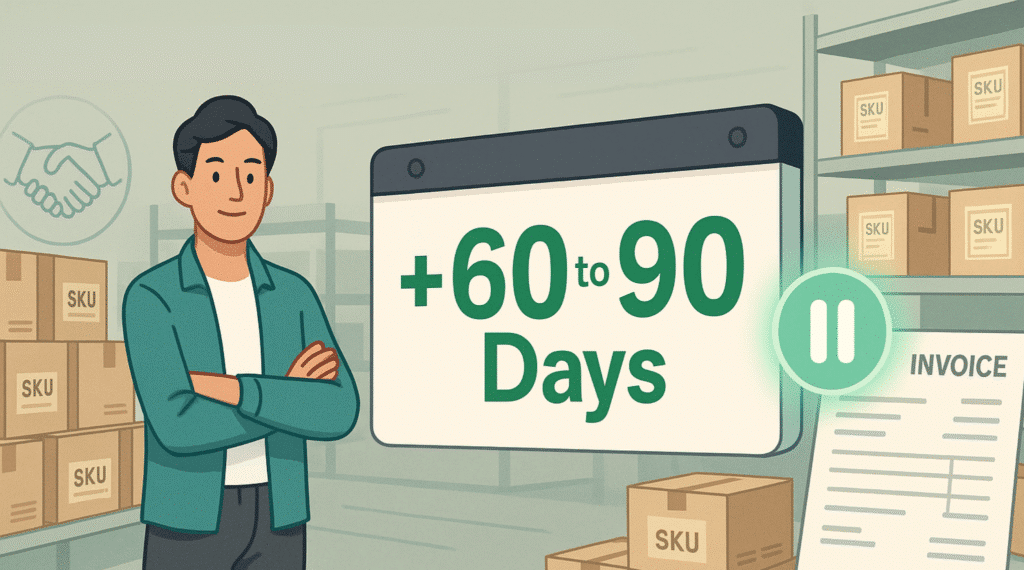- Distribution, Operations
Why Retail Buyers Love Crstl for EDI
By:

For founders trying to scale, getting ready for retail isn’t just about product or branding—it’s about putting in place systems to manage that growth. And for retail buyers, nothing signals operational readiness like a brand that’s EDI-capable.
Sponsored by Crstl a modern EDI provider priced for emerging brands that works with any retailer or distributor that uses EDI. I recommend them because of their easy to use platform, great customer service, and simple pricing. You can get onboarded with any retailer in 2 weeks or less + set up integrations in minutes. I negotiated with them for you to Save 25% off your entire first year, let me know if you’d like an introduction.
What EDI Means for Retailers and Brands
EDI (Electronic Data Interchange) might sound technical, but it simply refers to the digital exchange of key business documents—like purchase orders, invoices, and shipping confirmations—between retailers and brands. Instead of emailing PDFs or keying in data manually, EDI allows that information to flow directly between systems.
For retailers, EDI is critical. It reduces errors, saves time, and ensures smooth coordination across thousands of SKUs and suppliers. It’s how they manage high volumes and complex supply chains without everything grinding to a halt. Retail buyers are under constant pressure to keep shelves stocked, inventory flowing, and accounting reconciled. Working with brands that can plug into EDI means fewer headaches—and fewer escalations from operations or finance.
What Happens When Brands Aren’t EDI-Ready
When brands aren’t set up for EDI, they often rely on email chains, Excel sheets, and manual document uploads. That might work with one or two small retailers—but as your brand grows, it becomes a liability. Orders get delayed. Invoices don’t match POs. Shipment updates fall through the cracks.
For buyers, these issues aren’t just inconvenient—they’re risky. A delayed shipment means an empty shelf. A bad invoice means payment delays. Operational issues make buyers question if a brand is truly ready to scale. In many cases, retail teams will choose not to move forward with a brand at all unless it can commit to full EDI compliance.
Why Retail Buyers Specifically Love EDI-Ready Brands
Buyers have a tough job. They’re evaluated on performance—product sales, stockouts, turns, and margin. Every vendor they work with either makes that job easier… or harder.
Brands that are EDI-ready signal that they’re not just passionate about their product—they’re serious about their business. These brands are faster to onboard, more accurate with shipments and invoices, and more responsive to restock requests. That operational reliability builds trust, and trust builds lasting shelf space.
From a buyer’s perspective, working with an EDI-ready brand is a green flag. It means the brand understands retail systems, respects the buyer’s time, and is set up for long-term success.
How to Get EDI-Ready Without Losing Your Mind
Historically, setting up EDI was a painful process—high upfront costs, custom integrations, clunky legacy platforms, and never-ending IT tickets. For early-stage brands or lean teams, it often felt out of reach.
As a result, many founders kick the can down the road. They wait until a retailer requires it before scrambling to implement. But by that point, the pressure is on, and mistakes become more likely. The better path? Get EDI-ready before it becomes a blocker.
Making EDI Easy—The Rise of Plug-and-Play Solutions
Thankfully, the game has changed. Modern tools now make it easier than ever for brands to get EDI-capable—without needing a full tech team or six months of setup.
One standout in this space is Crstl, a no-code platform built to help CPG brands connect with retail partners quickly and easily. Crstl streamlines the entire EDI process—letting you exchange orders, invoices, ASNs, and more without needing to learn a single technical spec.
It integrates with popular platforms (like Shopify, Netsuite, QuickBooks, and more), offers real-time retail data sync, and automates compliance with retailers’ unique EDI requirements. In short: it removes the complexity from getting EDI-ready, so brands can focus on selling and scaling.
Real Benefits Brands Experience
Being EDI-ready doesn’t just please buyers—it boosts internal operations too. Brands that invest in EDI see faster order processing, fewer errors, quicker payments, and better cash flow forecasting.
Take, for example, a better-for-you snack brand that used Crstl to prepare for a national retailer launch. They were able to integrate their systems, test EDI workflows, and go live within weeks. The result? A smooth rollout, clean POs and invoices, and a buyer who’s now championing their expansion into more stores.
Final Thoughts
Being EDI-ready used to be a technical hurdle. Now, it’s a competitive advantage. For retail buyers, it’s a sign that your brand can be trusted to deliver—literally and figuratively. For founders, it’s a foundational investment that makes every future retail partnership smoother and more scalable.
Crstl is a modern EDI provider priced for emerging brands that works with any retailer that uses EDI. I recommend them because of their easy to use platform, great customer service, and simple pricing. You can get onboarded with any retailer in 2 weeks or less + set up integrations in minutes. I negotiated with them for you to Save 25% off your entire first year, let me know if you’d like an introduction.





